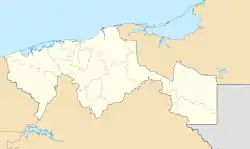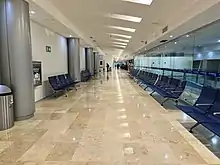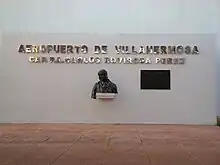Villahermosa International Airport Aeropuerto Internacional de Villahermosa | |||||||||||
|---|---|---|---|---|---|---|---|---|---|---|---|
 | |||||||||||
| Summary | |||||||||||
| Airport type | Public | ||||||||||
| Operator | Grupo Aeroportuario del Sureste | ||||||||||
| Serves | Villahermosa, Tabasco, Mexico | ||||||||||
| Opened | 1979 | ||||||||||
| Time zone | CST (UTC-06:00) | ||||||||||
| Elevation AMSL | 14 m / 46 ft | ||||||||||
| Coordinates | 17°59′42″N 92°49′02″W / 17.99500°N 92.81722°W | ||||||||||
| Website | www | ||||||||||
| Map | |||||||||||
 VSA Location of the airport in Tabasco  VSA VSA (Mexico) | |||||||||||
| Runways | |||||||||||
| |||||||||||
| Statistics (2022) | |||||||||||
| |||||||||||
Source: Grupo Aeroporturario del Sureste[1] | |||||||||||
Villahermosa International Airport (Spanish: Aeropuerto Internacional de Villahermosa); officially known as Aeropuerto Internacional Carlos Rovirosa Pérez (Carlos Rovirosa Pérez International Airport) (IATA: VSA, ICAO: MMVA) is an international airport located in Villahermosa, Tabasco, Mexico. It serves the Metropolitan Area of Villahermosa, the entire State of Tabasco, and Northern Chiapas. The airport offers domestic flights within Mexico and supports various tourism, flight training, and general aviation activities. It is named in honor of Carlos Rovirosa Pérez, a pioneer of Mexican aviation, who was born in Villahermosa. The airport is operated by Grupo Aeroportuario del Sureste (ASUR). In 2021, the airport handled 976,456 passengers, and in 2022, it served 1,214,190 passengers, according to ASUR.[1]
History
By 1935, the city of Villahermosa had three airfields: José Suárez Airfield (located in the current España neighborhood), El Playón Airfield (located in the city center), and Roberto Fierro Airfield (located in the area now known as Tabasco 2000). The Roberto Fierro Airfield received the inaugural cargo transportation flight of Compañía Mexicana de Aviación in 1928. It also welcomed the first passenger flight, which was conducted by a Ford brand trimotor monoplane from Mexicana de Aviación in 1929.[2]
As the city expanded in the late 1970s, a new airport was constructed in the Dos Montes community on the outskirts of the city. The current airport was inaugurated on May 2, 1979. Over the years, it has been served by various Mexican airlines, including Aeromar, Aero California, Aerocaribe, Aviacsa, Interjet, and Mexicana. It has also offered international services to Panama City through Copa Airlines and to Houston through Continental Express, Aeromexico Connect, and United Express, primarily catering to the oil industry market.
The passenger terminal underwent expansion in 2006 and was further expanded in 2013. Currently, Villahermosa Airport serves as the nearest active commercial airport to the popular tourist destination of the ancient Maya ruins in Palenque in Chiapas.
Facilities
The airport is situated at an elevation of 14 metres (46 ft) above sea level and it features a single runway, designated as 08/26, which measures 2,200 metres (7,200 ft) in length and has an asphalt surface. The commercial aviation apron has nine stands, with six being of type C and two of type D, primarily for narrow-body aircraft. The general aviation apron offers stands for fixed-wing aircraft and heliports for private aviation. The airport can handle up to 20 operations per hour.[3]
The passenger terminal is a two-story building with a total area of 12,769 square metres (137,440 sq ft). The lower level houses the check-in area, an arrivals hall with two baggage claim carousels, immigration and customs facilities, car rental services, taxi stands, snack bars, a souvenir shop, and a restaurant. The upper floor hosts the security zone and the departure concourse with a commercial area, restaurants, bars, a VIP lounge,[4] and five gates, four of which have jetbridges. The general airport offices are also located on this level. Adjacent to the terminal, other facilities include civil aviation hangars and designated spaces for general aviation.

Airlines and destinations
Passenger
| Airlines | Destinations |
|---|---|
| Aeroméxico | Mexico City |
| Aeroméxico Connect | Mexico City |
| Aerus | Poza Rica,[5] Reynosa,[5] Tampico, Veracruz |
| Mexicana de Aviación | Mexico City–AIFA[6] |
| Viva Aerobus | Cancún, Guadalajara, Mérida, Mexico City, Mexico City–AIFA (begins April 2, 2024),[7] Monterrey |
| Volaris | Guadalajara, Mexico City, Tijuana |
Cargo
| Airlines | Destinations |
|---|---|
| Aeronaves TSM | Mérida, Mexico City |
| Estafeta | Mérida, Mexico City, San Luis Potosí |
.jpg.webp)








Destinations map
 Villahermosa Destinations from Villahermosa International Airport Red = Year-round destination Blue = Future destination Green = Seasonal destination |
Statistics
Passengers
Busiest routes
| Rank | City | Passengers | Ranking | Airline |
|---|---|---|---|---|
| 1 | 413,243 | Aeromar, Aeroméxico, Aeroméxico Connect, VivaAerobús, Volaris | ||
| 2 | 75,385 | VivaAerobús | ||
| 3 | 44,370 | VivaAerobús | ||
| 4 | 41,669 | Aeromar, VivaAerobús | ||
| 5 | 15,757 | MAYAir, VivaAerobús | ||
| 6 | 2,086 | Aeroméxico Connect | ||
| 7 | 914 | United Express |
See also
- List of the busiest airports in Mexico
- List of airports in Mexico
- List of airports by ICAO code: M
- List of busiest airports in North America
- List of the busiest airports in Latin America
- Transportation in Mexico
- Tourism in Mexico
- Grupo Aeroportuario del Sureste
- Centro Municipality, Tabasco
- Petroleum industry in Mexico
- Palenque
References
- 1 2 "Passenger's Traffic" (in Spanish). ASUR. Retrieved 11 January 2023.
- ↑ "Historia de la aviación en Tabasco: De aeropuerto a zona residencial y comercial en Villahermosa" (in Spanish).
- ↑ "NUESTROS AEROPUERTOS" (in Spanish).
- ↑ ".:Caral:. vip lounge". www.caralvip.com. Retrieved 29 October 2023.
- 1 2 "Nuestros destinos". FlyAerus (in Spanish). November 2023. Retrieved 18 November 2023.
- ↑ "These Are Our Destinations". Mexicana (in Spanish). October 2022. Retrieved 4 October 2023.
- ↑ "Viva Aerobus Bets Big on AIFA: 17 New Routes". Aviacionline. September 2023. Retrieved 28 September 2023.
- ↑ "Estadística operacional por origen-destino / Traffic Statistics by City Pairs" (in Spanish). Agencia Federal de Aviación Civil. January 2023. Retrieved 26 January 2023.
External links
 Media related to International Airport Carlos Rovirosa Pérez at Wikimedia Commons
Media related to International Airport Carlos Rovirosa Pérez at Wikimedia Commons- Official website
- Grupo Aeroportuario del Sureste ASUR
- Villahermosa Airport information at Great Circle Mapper
- Aeronautical chart and airport information for MMVA at SkyVector
- Current weather for MMVA at NOAA/NWS
- Accident history for VSA at Aviation Safety Network
- Tourism in Villahermosa